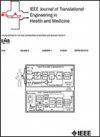Single Camera-Based Gait Analysis Using Pose Estimation for Ankle-Foot Orthosis Stiffness Adjustment on Individuals With Stroke
IF 4.4
3区 医学
Q2 ENGINEERING, BIOMEDICAL
IEEE Journal of Translational Engineering in Health and Medicine-Jtehm
Pub Date : 2025-07-02
DOI:10.1109/JTEHM.2025.3585442
引用次数: 0
Abstract
Introduction: Stroke is one of the most common causes of impaired gait. The use of an ankle-foot orthosis (AFO) is one of the recommended methods to improve gait function in stroke patients. Although the stiffness of the AFO is adjusted for each stroke patient, the effect of stiffness adjustment remains unclear due to the difficulty in measuring the gait parameters in a clinical setting. Objective: This study aimed to investigate the effect of adjusting the AFO stiffness based on the gait ability of stroke patients using a markerless gait analysis method. Methods: A total of 32 individuals with stroke were directed to walk under five conditions: no-AFO and AFO with four different levels of spring stiffness. These springs were used to resist the plantarflexion movements. Moreover, the best gait speed improvement condition (best condition) was determined from the five gait conditions for each participant and was compared with the other conditions, assuming a clinical setting. Spatiotemporal gait parameters such as the gait speed, cadence, step length, stance phase, and swing phase were measured from body keypoints in RGB images. Results and Conclusion: The experimental results showed that the gait speed, cadence, step length on both sides, and stance time on both sides were significantly improved in the best condition compared with the other conditions. This study demonstrated the usefulness of the markerless gait analysis method using a single RGB camera and the effectiveness of AFO stiffness adjustment based on the gait ability of the users.基于姿态估计的单摄像头步态分析用于中风患者踝足矫形器刚度调整
中风是步态受损最常见的原因之一。使用踝足矫形器(AFO)是改善脑卒中患者步态功能的推荐方法之一。虽然每个中风患者都调整了AFO的刚度,但由于在临床环境中难以测量步态参数,因此调整刚度的效果尚不清楚。目的:采用无标记步态分析方法,探讨基于脑卒中患者步态能力调整AFO刚度的效果。方法:对32例脑卒中患者进行5种不同条件下的步行训练,分别为无足部矫直和足部矫直,并伴有4种不同程度的弹簧刚度。这些弹簧被用来抵抗跖屈运动。此外,从每个参与者的五种步态条件中确定最佳步态速度改善条件(最佳条件),并与其他条件进行比较,假设临床设置。从RGB图像的身体关键点测量步态速度、步频、步长、站立相位和摆动相位等时空步态参数。结果与结论:实验结果表明,与其他条件相比,最佳条件下的步态速度、步频、两侧步长、两侧站立时间均有显著改善。本研究证明了使用单个RGB相机的无标记步态分析方法的有效性,以及基于用户步态能力调整AFO刚度的有效性。
本文章由计算机程序翻译,如有差异,请以英文原文为准。
求助全文
约1分钟内获得全文
求助全文
来源期刊

IEEE Journal of Translational Engineering in Health and Medicine-Jtehm
Engineering-Biomedical Engineering
CiteScore
7.40
自引率
2.90%
发文量
65
审稿时长
27 weeks
期刊介绍:
The IEEE Journal of Translational Engineering in Health and Medicine is an open access product that bridges the engineering and clinical worlds, focusing on detailed descriptions of advanced technical solutions to a clinical need along with clinical results and healthcare relevance. The journal provides a platform for state-of-the-art technology directions in the interdisciplinary field of biomedical engineering, embracing engineering, life sciences and medicine. A unique aspect of the journal is its ability to foster a collaboration between physicians and engineers for presenting broad and compelling real world technological and engineering solutions that can be implemented in the interest of improving quality of patient care and treatment outcomes, thereby reducing costs and improving efficiency. The journal provides an active forum for clinical research and relevant state-of the-art technology for members of all the IEEE societies that have an interest in biomedical engineering as well as reaching out directly to physicians and the medical community through the American Medical Association (AMA) and other clinical societies. The scope of the journal includes, but is not limited, to topics on: Medical devices, healthcare delivery systems, global healthcare initiatives, and ICT based services; Technological relevance to healthcare cost reduction; Technology affecting healthcare management, decision-making, and policy; Advanced technical work that is applied to solving specific clinical needs.
 求助内容:
求助内容: 应助结果提醒方式:
应助结果提醒方式:


